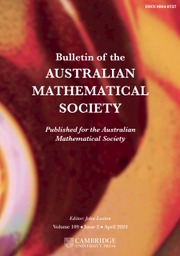No CrossRef data available.
Article contents
Some inequalities for diophantine approximation by continued fractions
Published online by Cambridge University Press: 17 April 2009
Abstract
Core share and HTML view are not available for this content. However, as you have access to this content, a full PDF is available via the ‘Save PDF’ action button.
Let ξ be an irrational number with simple continued fraction expansion ξ = [a0;a1,a2,…,an,…], let pn/qn be its nth convergent and let θn = qn|qnξ − pn|. In this paper a general method is introduced to deduce a series of inequalities involving the triple (θn−1, θn, θn+1).
- Type
- Research Article
- Information
- Copyright
- Copyright © Australian Mathematical Society 1990
References
[1]Brauer, A. and Macon, N., ‘On the approximation of irrational numbers by the convergents of their continued fractions’, Amer. J. Math. 71 (1949), 349–361. 72 (1950), 419–424.CrossRefGoogle Scholar
[2]Jager, H. and Kraaikamp, C., ‘On the approximation by continued fractions’, Indag. Math. (to appear).Google Scholar
[4]Macon, N., ‘Some theorems on the approximation of irrational numbers by the convergents of their continued fractions’, J. Elisha Mitchell Sci. Soc. 67 (1951), 99–107.Google Scholar
[6]Schmidt, W., Diophantine Approximations, Lecture Notes in Math. 785 (Springer-Verlag, Berlin, Heidelberg, New York, 1980).Google Scholar
[7]Tong, J., ‘The conjugate property of the Borel theorem on Diophantine approximation’, Math. Z. 184 (1983), 151–153.CrossRefGoogle Scholar
[8]Tong, J., ‘The conjugate property for Diophantine approximation of continued fractions’, Proc. Amer. Math. Soc. 105 (1989).CrossRefGoogle Scholar


